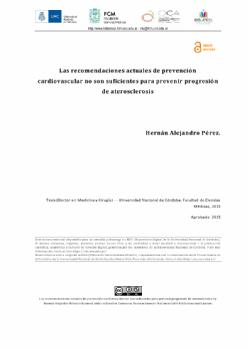| dc.contributor.advisor | García, Néstor | |
| dc.contributor.author | Pérez, Hernan Alejandro | |
| dc.date.accessioned | 2021-12-02T17:27:10Z | |
| dc.date.available | 2021-12-02T17:27:10Z | |
| dc.date.issued | 2015-12 | |
| dc.identifier.uri | http://hdl.handle.net/11086/21853 | |
| dc.description | Tesis - Doctorado en Medicina y Cirugía - Universidad Nacional de Córdoba. Facultad de Ciencias Médicas, 2015. | es |
| dc.description | 72 p. | |
| dc.description.abstract | INTRODUCCION: Las eventos cardiovasculares (EVC), son un importante problema de salud pero potencialmente prevenibles. Tradicionalmente, el riesgo de presentar aterosclerosis, principal causa de ECV isquémicos, ha sido asociado a factores de riesgo cardiovasculares tradicionales (FR) y la valoración clínica de este riesgo, calculada con estimadores clínicos (ej. Framingham), los cuales presentan importantes limitaciones al momento de detectar personas a con alto riesgo cardiovascular (CV). El abordaje terapéutico preventivo de estos eventos, según las guías clínicas, debería estar basado en el control de estos factores de riesgo principalmente, aunque la efectividad clínica de este abordaje es bastante limitada, y hay evidencia de que realizar la valoración y el seguimiento basado en Área de Placa Total Carotidea (TPA) mejora la sensibilidad de detección de pacientes de alto riesgo cv y posiblemente la efectividad preventiva de esta intervención. Es por esto que nuestra hipótesis fue que el control de FR no es suficiente para disminuir la progresión de aterosclerosis de los pacientes con alto riesgo CV por TPA.
MATERIAL Y MÉTODOS: Se diseñó un estudio prospectivo observacional de 302 pacientes con alto riesgo CV del programa de Blossom DMO. Estos pacientes fueron controlados por al menos 1 año, con determinación de TPA al comienzo y al final, y todos los FR controlados según guías clínicas, comparando porcentajes de pacientes en progresión al año de tratamiento, porcentaje de pacientes en progresión con Hb A1c menor de 7%, y niveles de marcadores inflamatorios en pacientes con progresión.
RESULTADOS: De los pacientes con alto riesgo CV, y control en todos los FR CV clásicos, el 46% presentaron al año de seguimiento, criterios de progresión por TPA. En la subpoblación de pacientes diabéticos con Hb A1c menor de 7% al año, y los demás FR controlados, progresaron el 48%. Finalmente, la comparación de Microalbuminuria, Fibrinógeno, PCR uc cuantitativa y Homocisteína no fueron diferentes al analizarlas en aquellos pacientes que progresaron contra los que no progresaron.
CONCLUSIONES: Un alto porcentaje de pacientes (≈50%) con alto riesgo CV tratados según guías clínicas, con todos los FR controlados, presentaron criterios de progresión por TPA al año de seguimiento. No se evidenciaron diferencias significativas en los marcadores inflamatorios en pacientes con progresión comparados a aquellos con estabilidad o regresión. En vista de estos resultados, el seguimiento de pacientes de alto riesgo CV debería basarse, no solamente en el control de FR CV, sino también en la evolución de aterosclerosis subclínica, medida por TPA. | es |
| dc.description.abstract | INTRODUCTION: Cardiovascular events (CVD) are an important health problem but potentially preventable. Traditionally, the risk of presenting atherosclerosis, the main cause of ischemic CVD, has been associated with traditional cardiovascular risk factors (RF) and the clinical assessment of this risk, calculated with clinical estimators (e.g. Framingham), which present important limitations at the time of detecting people with high cardiovascular (CV) risk. The preventive therapeutic approach to these events, according to clinical guidelines, should be based mainly on the control of these risk factors. However, the clinical effectiveness of this
approach is quite limited and there is evidence that conducting the assessment and follow-up based on Total Carotid Plaque Area (TPA) improves the sensitivity of detection of patients at high CV risk and possibly the preventive effectiveness of this intervention. Therefore, our hypothesis was that RF control is not sufficient to reduce the progression of atherosclerosis in patients with high CV risk due to TPA.
MATERIAL AND METHODS: a prospective, observational study of 302 patients with high CV risk of the Blossom BMD program was designed. These patients were checked for at least 1 year, with determination of TPA at the beginning and at the end, and all RF controlled according to clinical guidelines, comparing the percentage of patients in progression after one year of treatment, the percentage of patients in progression with Hb A1c less than 7%, and levels of inflammatory markers in patients with progression.
RESULTS: Of the patients with high CV risk, and control in all the classic CV RFs, 46% presented APD progression criteria at one year of follow-up. The subpopulation of diabetic patients with Hb A1c less than 7% per year, and the other controlled RFs, progressed by 48%. Finally, the comparison of Microalbuminuria, Fibrinogen, PCR uc quantitative and Homocysteine were not different when analyzed in those patients who progressed versus those who did not.
CONCLUSIONS: A high percentage of patients (≈50%) with high CV risk treated according to clinical guidelines, with all RF controlled, presented progression criteria for TPA at one year of follow-up. There were no significant differences in inflammatory markers in patients with progression compared to those with stability or regression. In view of these results, the follow-up of high-risk CV patients should be based, not only on the control of CV RF, but also on the evolution of subclinical atherosclerosis, measured by TPA. | es |
| dc.language.iso | spa | es |
| dc.rights | Atribución-NoComercial 4.0 Internacional | * |
| dc.rights.uri | http://creativecommons.org/licenses/by-nc/4.0/ | * |
| dc.subject | Aterosclerosis | es |
| dc.subject | Factores de riesgo de enfermedad cardíaca | es |
| dc.subject | Biomarcadores | es |
| dc.subject | Marcadores inflamatorios | es |
| dc.subject | Área de placa total carotídea | es |
| dc.title | Las recomendaciones actuales de prevención cardiovascular no son suficientes para prevenir progresión de aterosclerosis | es |
| dc.type | doctoralThesis | es |
| dc.description.fil | Fil: Pérez, Hernán Alejandro. Universidad Nacional de Córdoba. Facultad de Ciencias Médicas; Argentina. | es |





